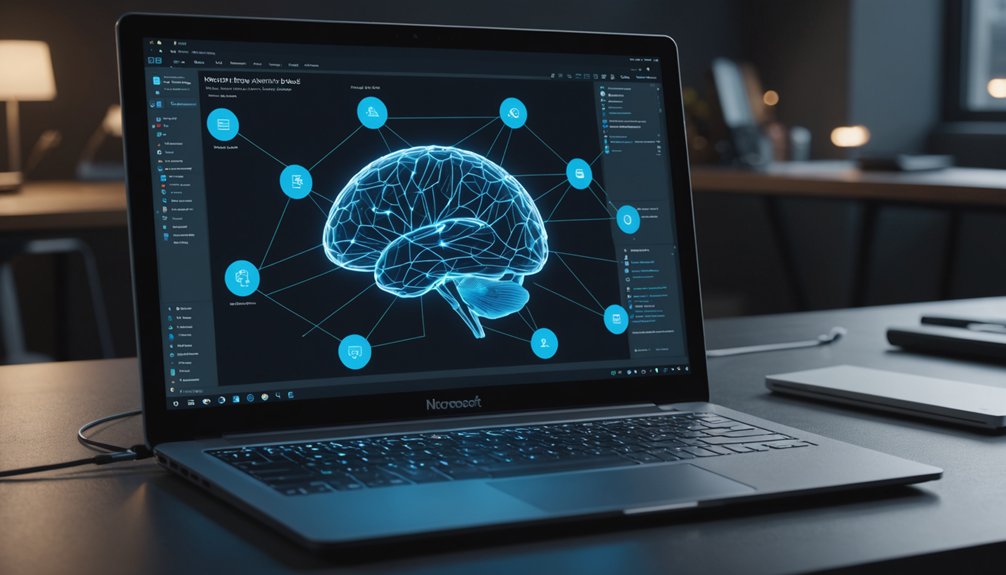Hugging Face Transformers makes NLP accessible to everyone with pre-trained models. Install it with pip, then select the right model for your task – BERT for classification, GPT for generation, you get the idea. The library handles complex operations behind the scenes. No need for massive datasets or computational resources. Tasks like translation, summarization, and sentiment analysis become surprisingly simple. The extensive documentation helps newcomers navigate the once-intimidating NLP landscape.

While traditional NLP methods once required extensive coding and manual feature engineering, Hugging Face Transformers has completely changed the game. This open-source library has revolutionized natural language processing by providing easy access to pre-trained models that leverage self-attention mechanisms. No more reinventing the wheel. These models understand context better than your ex understood your needs.
The library supports a wide range of applications. Text classification? Check. Sentiment analysis? Obviously. Machine translation? You bet. And the community behind it is massive. Documentation everywhere. Resources galore. It's almost too easy. These transformer models excel at understanding context through their attention mechanisms that help weigh the importance of words in relation to each other. The Hugging Face Hub allows users to easily share models with versioning capabilities and hosted inference features. With over 900k models available, developers can find solutions for virtually any NLP task.
Choosing the right pre-trained model is critical. Want to generate text? GPT-3 or GPT-2 will do the trick. Need to answer questions? BERT, RoBERTa, or ALBERT have you covered. Sentiment analysis works best with DistilBERT or BERT. It all depends on your specific task. Hugging Face's Model Hub has everything. Browse it. Use it. The problem definition phase ensures you select the most appropriate model for your needs.
Model selection is half the battle. Choose BERT for questions, GPT for generation, and watch your NLP tasks soar.
Getting started is surprisingly simple. A single pip install command. Done. You'll need Python knowledge, obviously. Some understanding of deep learning concepts helps too. Tutorials are everywhere. Forums exist for a reason.
Pipelines make execution dead simple. Specify your task—translation, summarization, question answering—and let it run. The library defaults to appropriate models if you're too lazy to choose. GPU optimization comes built-in. Batch processing? Supported.
Advanced tasks are no problem. Named Entity Recognition identifies entities in text. Part-of-speech tagging categorizes words grammatically. Topic modeling uncovers themes. Question answering finds relevant information. Machine translation preserves meaning across languages.
Fine-tuning takes things further. Adapt pre-trained models to your specific datasets. Adjust parameters. Optimize batch sizes. Use multiple GPUs if you're fancy. The performance gains can be substantial. Transformers isn't just a library. It's a revolution in accessibility for NLP tasks.
Frequently Asked Questions
How Do I Optimize Transformers for Deployment on Edge Devices?
Optimizing transformers for edge deployment requires strategic moves.
Weight quantization drops models to 8-bit or 4-bit precision.
Model distillation transfers knowledge from large to smaller models—think DistilBERT instead of full BERT.
Hardware-specific tools like OpenVINO and Optimum-Intel API streamline deployment.
Pruning cuts unnecessary weights.
Mixed-precision training reduces memory footprint.
Edge devices can't handle bloated models.
Performance benchmarking guarantees real-world viability.
Can I Use Transformers for Low-Resource Languages Effectively?
Transformers can indeed tackle low-resource languages. Models like mBERT and XLM-R support dozens of languages through shared vocabulary and subword embeddings.
Not perfect, though. Fine-tuning on available data is essential. Cross-lingual transfer helps—borrow knowledge from related high-resource languages. Hyperparameter optimization makes a substantial difference.
In-domain corpora? Game-changer. BLEU scores improve markedly with the right approach.
Sentiment analysis and NER? Totally doable.
What GPU Memory Requirements Exist for Larger Transformer Models?
Larger transformer models are memory hogs. Period. They typically need 2GB of VRAM per billion parameters for basic inference, but fine-tuning? Way more demanding.
Quantization techniques can save your GPU from melting – dropping from 32-bit to 8-bit precision drastically cuts requirements. Libraries like 'bitsandbytes' make this easier.
Without these tricks, you'd need industrial-grade hardware just to run the big boys.
How Do I Handle Token Limitation Issues With Long Texts?
Token limitations are a real headache with long texts. Period.
To handle them, you've got options: truncate the text, chunk it into smaller pieces, or use specialized models like Longformer that handle up to 4096 tokens.
Some folks pad texts for consistency, others adjust max_length parameters during tokenization. Dynamic padding works great for varying lengths.
The right approach? Depends on your task requirements and computational resources. No one-size-fits-all solution here.
Can Transformers Be Effectively Fine-Tuned With Synthetic Data?
Yes, transformers can be effectively fine-tuned with synthetic data.
It's becoming quite popular. Synthetic data solves scarcity problems, maintains privacy, and cuts costs.
Tools like Hugging Face's 'synthetic-data-generator' make this process straightforward.
Models like SmolLM and ModernBERT have shown promising results with this approach.
The process is faster too. Not as resource-hungry as training with massive real-world datasets.




